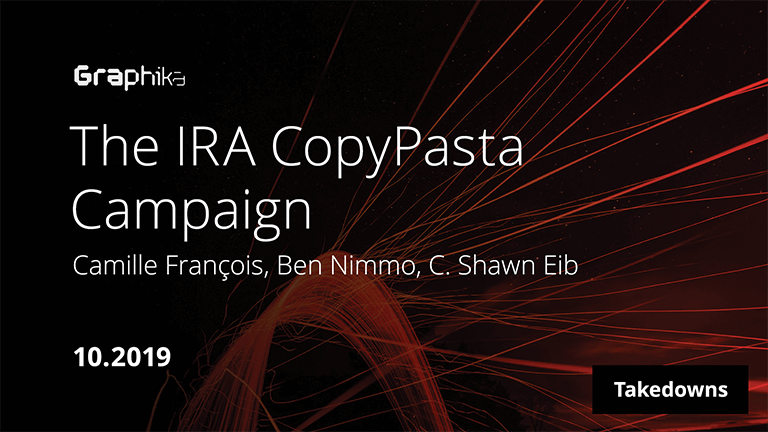

Graphika Report
Monday October 21, 2019
The IRA CopyPasta Campaign
Camille Francois, Ben Nimmo, C. Shawn Eib
Read Full ReportRussian Accounts Posing as Americans on Instagram Targeted Both Sides of Polarizing Issues Ahead of the 2020 Election
On October 21, 2019, Facebook announced the takedown of 50 Instagram accounts posting about US social and political issues and the 2020 election. Facebook concluded that the operation “originated from Russia” and “showed some links to the Internet Research Agency (IRA)”, the Russian “troll farm” that previously targeted US audiences and the United States presidential election in 2016.
These accounts, all linked to the same operation, claimed to represent multiple politically active US communities: black activist groups, advocates speaking out against police violence, police supporters, LGBTQ groups, Christian conservatives, Muslims, environmentalists, gun-rights activists, southern Confederates, and supporters of Senator Bernie Sanders and President Donald Trump. A minority of posts focused directly on the 2020 election. Multiple accounts praised Bernie Sanders or Donald Trump. Accounts from both sides of the political spectrum attacked Joe Biden; some also attacked Kamala Harris and Elizabeth Warren. Almost half the accounts claimed to be based in “swing states,” especially Florida.
This choice of targets and content echo the campaigns previously deployed by the IRA. Additionally, a few of the posts in this set reused or recreated IRA memes: this is why we named this campaign “IRACopyPasta”. That these accounts reused and recreated IRA content is insufficient grounds on its own to provide a firm attribution, but it aligns with Facebook’s own analysis that the operation showed some links to the IRA.
The operators went to great lengths to hide their origins, prioritizing operational security (OPSEC) over audience growth. Many of their posts consisted only of memes, without accompanying text. Posts that included text were usually sourced from viral posts made by American accounts. Facebook noted of this operation that it “had the hallmarks of a well-resourced operation that took consistent operational security steps to conceal their identity and location.”
Most of these accounts had low numbers of followers: over half had fewer than 5,000 followers, and only one, focused on environmental issues, had over 20,000. The total number of posts for this operation was just under 75,000. The campaign appeared to be a recent creation, using purpose-made accounts rather than accounts compromised from real users. Some posts gained hundreds of likes but typically obtained orders of magnitude fewer than the American personalities they copied. The operation appears to have been active almost exclusively on Instagram. Nevertheless, it made heavy use of Twitter by posting screenshots of tweets from genuine American users to Instagram.
Read Full Report